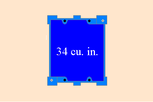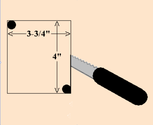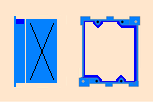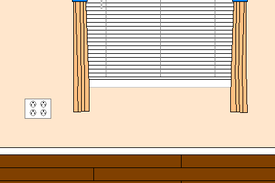How to Build a Hide A Safe to Protect The Family Jewels
Build a hide a safe to protect the family jewels. Home security being of major concern these days, a 'hide a safe' or diversion safe is surprisingly easy to create! Once a burglar trips an alarm system, they know they have but a short time to grab and run before Law Enforcement shows up. You can believe they practice! They know all the usual places people habitually store valuables thinking they're safe. That's right, they know about the freezer compartment, back of the dresser drawer, under the mattress, the closet and the cookie jar! They'll hit them first! What do you do? Hide valuables in ways that take way too long to discover. The best place to hide anything is in plain sight!
In this tutorial, I'll show you how to create a diversion safe built into a false Double-Gang Receptacle.
In this tutorial, I'll show you how to create a diversion safe built into a false Double-Gang Receptacle.
|
Things You'll Need:
* Tape Measure * Keyhole Saw and Hacksaw * Stud Finder w/ AC Scan * Pencil |
* Carlon 34 cu. in. Two Gang (Double-Gang) Old Work Box
* Fine sandpaper * Two 15-Amp Grounding Receptacles (cheap ones) * Duplex Receptacle Wall plate * Phillips and Standard Screwdrivers |
|
1. Make this as realistic as possible. You need to make this false duplex receptacle look like it belongs there. For conformity, it is important that this appear as if it was installed at the same time as the rest. No one will ever notice your hide a safe! Begin by removing the cover plate of an existing receptacle. Measure from the floor up to the bottom of the box (typically, between 9-12 inches). Once complete, this should provide approximately 340 cubic inches of hidden storage space!
2. Decide where to locate your hide a safe. Put it somewhere easily accessible, so you won't have to slide heavy furniture out of the way. But not too near an existing receptacle or it could stick out as excessive. 3. Locate the hollow space between wall studs. While you could just tap on the wall, listening for sound changes, that won't alert you to hidden electrical wiring. I recommend using a Stud Finder w/ AC Scan. (see Tips) If you install your hide a safe in an exterior wall, fiberglass batt insulation may hold (typically installed) Romex electrical wiring against the Drywall. A saw blade could easily damage the insulated sheathe and cause a short.  Double-Gang box
4. Mark the bottom and one side of the opening to cut out, mindful of the wall stud locations. Once you have found a "safe" location, place the open face of the double-gang old work box level against the wall and trace it with a pencil.
 Keyhole Saw Keyhole Saw
5. Cut two holes in diagonal corners. Insert the tip of the Keyhole saw through the Drywall and cut away from the corners. Remove the section and try the old work box for fit.
 Box Collar Box Collar
6. Use a hacksaw to cut away the back portion of the box, cutting just behind the locking tabs. Use fine sandpaper to remove sharp edges, before inserting this collar into the wall opening. Rotate the locking tabs by turning both Phillips head screws clockwise. This collar provides a secure surface for the receptacles and cover plate.
7. Place your valuables inside the wall cavity and install the receptacles and plate to complete the disguise. This hidden wall safe should hold a fair amount of Jewelry or Cash. Unlike similar (single receptacle) diversion safes advertised for sale, this mockup looks every bit as realistic and solid as the real thing. True, there is no hinge and it requires removing six screws. But a burglar will never discover it. Especially if you plug in a heated air freshener, a battery-operated lamp with a fake cord or even an extension cord routed behind furniture.
Tips * Having trouble locating a hidden wall stud? Measure in from an exterior wall; modern construction dictates a spacing of 16" on center. Test first with a finishing nail. Drill a 3/4" hole, insert your finger and check from side to side. A double-gang box will require approximately 3-3/4" x 4". * Because of the size of the opening, you should have no trouble using this cavity as a handgun safe, for example. At only 9 inches from the floor, with the typical stud spacing of 16 inches on center, this gives you approximately 340 cubic inches of hidden storage space! * Bathroom walls are often insulated, as a means of privacy. * You could also install this safe without cutting the box away, at wall switch level, using a pair of single-pole switches or a switch/receptacle combination. Even a blank Wall plate will do. * Going on vacation? There's a wide variety of portable travel/diversion safes available to secure what you don't squirrel away at home. * In a pinch for time? Seal valuables in a soup can with a pet food lid, inside of a larger coffee container topped with fresh coffee grounds, or inside a 5-gallon bucket with a lid! Warnings * This is not a fireproof safe! * Enclose objects in plastic zip-loc bags to protect against corrosion or insect damage. Moisture from hot showers and cooking can permeate walls. Copyright 5/19/2009 All Rights Reserved. Questions? Comments? Contact Me Related Articles: Interior |
#ad #ad |
